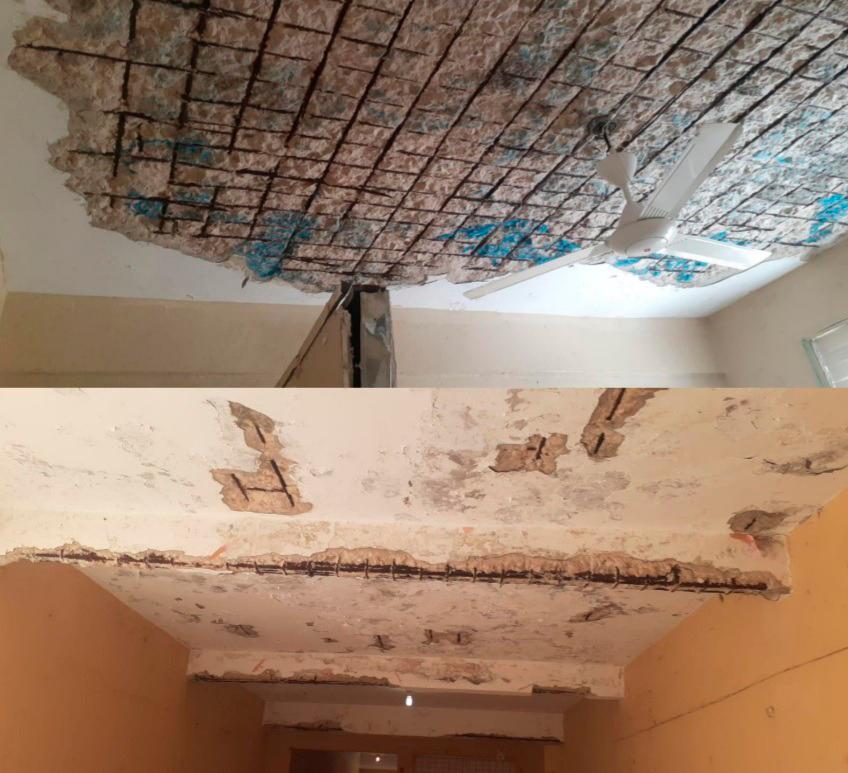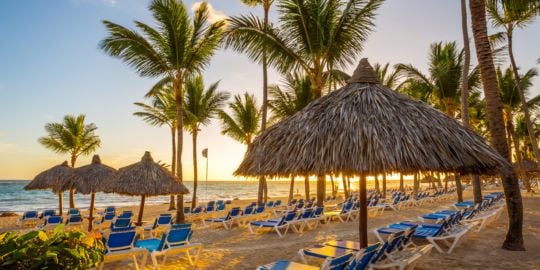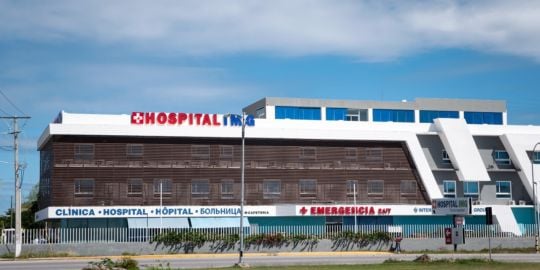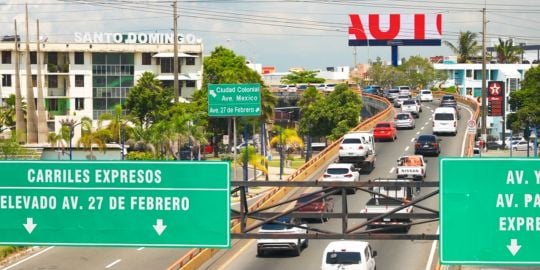Construction quality control is something that should be a concern for all expats especially because of the vulnerability of the country to flood, wind and earthquake risks. If you are building a new property or buying into a new property, you need to be assured of the quality of construction and perhaps make sure there are collaral indemnity insurances in place albeit the period aof validity is short in DR. If you are renting a property review the general state of the building before signing that lease.
The report posted below which has followed damage froma relatively light earthquake in the Puerto Plata province, which is a high risk earthqauke, highlights the quality problems in masonry and concrete work.
The photograph shown tells me that the reinforced concrete work in that school was very poor with weak concrete (the colour suggest a low cement content and lack of compaction) and low poorly compacted concrete cover too to the reinforcement which has led to spalling after rusting. Puerto Plata along with much of DR needs higher levels of concrete cover to reinforcement to counteract the effects of salt air but it is poor uncompacted concrete that enhances any corrosion of the reinforcing bar which is essential to transmit tensile and shear forces.
You can't easily repair what is shown other than to demolish and rebuild.
Out of 10,000 schools, including new ones, 6,000 do not withstand a serious earthquake
290 of them need urgent intervention
They are located on top of tectonic faults
The northern region of the country is the most vulnerable
https://www.diariolibre.com/actualidad/ … AB30135555
Of the 10,000 schools in the Dominican Republic, about 6,000 do not withstand a major earthquake, since they have not been built with an earthquake-resistant design, including the new ones that have been built since 2013, the year in which they began to invest 4% of the Gross Domestic Product in education. This represents 60% of a significant part of the workforce of educational centers nationwide.The physical structure of the schools is not equipped with a minimum number of elements in each direction, specifically placed to resist the onslaught of the forces of an earthquake of considerable magnitude, which are becoming more and more present in the Caribbean area.One evidence of this is what happened in Puerto Plata, where 13 schools were seriously affected in their structure by the earthquake registered in the early hours of Monday - 4.7............................
Construction Quality Control
How difficult is it to get a reliable inspector?
You could get a cost for the structural engineer to visit at key times during the masonry and concrete construction.
If you are paying MOPC a fee they should inspect at key points but the above school photos suggest they aren't always thorough.
Your maestros are the key imo and that is where knowledge of Spanish comes in. Most expats involved in constructing their own properties will probably be dealing with a contractor who speaks in English but he relies on his maestros too.
I am a recently retired home inspector from Nova Scotia, now living in the North Shore area of the DR. In my opinion, if you are truly concerned, it would be money well spent hiring a Structural Engineer to inspect a house. Hiring a General Contractor is also a good idea, but then you will have to be concerned about whether or not they are creating work for themselves. A normal home inspection in Canada is limited to what the inspector can see as per association code of ethics, but construction practices in the DR are so far removed from normal North American practices that an expert is required. Not sure if there is even a building code in the DR, at least (from what I have seen) nothing that has been updated or enforced in decades.
Having recently been involved in some "inspections" they can also be a crapshoot! Many of them don't know the rules, don't have the equipment are unbelievably slow and not thorough.
lennoxnev wrote:You could get a cost for the structural engineer to visit at key times during the masonry and concrete construction.
If you are paying MOPC a fee they should inspect at key points but the above school photos suggest they aren't always thorough.
Your maestros are the key imo and that is where knowledge of Spanish comes in. Most expats involved in constructing their own properties will probably be dealing with a contractor who speaks in English but he relies on his maestros too.
Hi lennoxnev, in your experience, what is the best way to look for and contract a maestro de obra in the DR? I'm looking to build a site with some off grid infrastructure and most people I talk to suggetst to find someone in the capital even though the work is to be done in El Seibo.
It is nonsense to look for a maestro from Santo Domingo for work in El Seibo.
El Seibo is a big enough provincial town and no doubt there is plenty of building work going on. You must have contacts in that town/province and by asking them is where you start to find your maestro.
I live in a sparsely populated part of DR in north Monte Plata province and have found two good general maestros one from our village and one from Sabana.
Once you identify the maestro he will identify best general construction materials and builders merchants. Spanish proficiancy or reliable Dominican friends will help.
The thing is that my friends here, I'd say a quarter of them Dominican say the same thing, that there are no good construction professionals outside of the cities, and that if I have contacts in Sto Dgo to use them as they usually have more expertise and access to file for paperwork and such. I'm in the middle of finalizing some details on a land purchase, I will ask the seller to refer someone in the region, as my contacts are all either in the capital or here in Punta Cana, where they say if I'm not building a hotel or villa, don't bother.
My experience is the good meastros in the cities or Punta Cana come from the interior and work for contractors in the building boom there.
And why would a maestro want to work in El Seibo where they would incur lodgings and dont know the local labour? But if you pay well they might consider.
I guess it depends what you are building.
I am not talking about contractors when I talk of maestros. I am referring to the local master builder who works on a labour only basis typically.
If you are looking for a good contractor perhaps you should look no further than La Romana. There are some very good ones there and they have their own maestros that they keep regularly employed. I can dig up a couple of names.
That would be great, I appreciate your feedback. I don't even think it adds to the conversation but in some other DR forums they've concluded that La Romana is one of the worst places to do business in, but again, only here 1 year and living and learning. On the other hand I've heard good things about Higuey, just don't know anyone there.
What is the difference between a maestro de obra and contractor? And who would be responsible for the quality control of the construction?
I have just sent you a PM listing two construction companies in La Romana with whom I have personally met whilst finalizing villa contracts several years ago and who were very professional and have quality work to back this up.
Both have been involved in Caso De Campo work.
In theory a 'maestro de obra' is your master builder but could be trade specific.
https://www.mopc.gob.do/servicios/direc … icaciones/
In theory the best have a MOPC license.
Most building contractors employ several meastros and they will share out the work on a larger contract. The maaestro supplies, pays and manages the labour and the contractor will have a contracts manager( perhaps non resident) to manage the work overall and order the materials etc.
For a smaller typical domestic building you save a lot by employing directly maestros on a labour only basis and buying the materials he will list for you.
A construction permit needs to be submitted by a CODIA registered person and that will normally be the architect or structural engineer.
https://www.mopc.gob.do/servicios/direc … ci%C3%B3n/https://www.codia.org.do/
The sitaution in DR is that at least 90% of all buildings, small and large, being or been built have no construction permit. I bet there are many ongoing constructions, especially the smaller ones, in El Seibo without a construction permit. Bigger building work usually has a buiding permit. In certain areas you will also need enviromental and tourism ministry permits too. There lies the problem with quality with no external checking. If you live here you will be able to check the work.
The press have reported this collapse but there is scant information other than the collapse is being investigated. From the photographs and videos that I have seen, it suggests a failure of the upper slab support falsework during a concrete pour.
These things happen in DR......
Building roof collapses in the Senate
https://noticiassin.com/pais/colapsa-te … do-1225623
The collapse that occurred on Tuesday afternoon in the part of the roof of the construction of the new Senate dining room is kept in total secrecy.
In full execution of the work, the collapse occurred, with no reports of victims or serious damage.
We are going to build with the M2 panels. Developed in Italy to withstand seismic activity. (35+ years building around Mediterranean and Latin America) They have a factory in Santo Domingo. But is hard to find people well versed in how to build with them. But they are around.
www.m2dominicana.com
The link posted M2Dominicana is not opening fully.
However you can quickly determine the company M2Baltra is linked with Isotex Dominicana by clicking on 'contact' or googling M2Baltra and finding they are based at the Isotex premises in Santo Domingo.
Here is the Isotex website:
https://isotexdominicana.com/#
I would approach Isotex direct to get an approved contractors and quotation.
In DR traditional time tested construction is masonry and concrete and that explains why very few contractors will understand polystyrene based constuction. It could be to current DR seismic codes if the foundations to the superstructure are designed accordingly and the overall design vetted by a certified CODIA structural engineer.
I have no experience of this form of construction but it will require a level of technical understanding and quality control in the building process. How do insurers view this form of construction? You must ensure the 'type of construction' is clearly defined in any all risks insurance policy because that will be the first item checked in any future claim for loss and if defined incorrectly could negate any claim. The underwriters could seize at the opportunity to knock back any claim if it is defined as masonry construction because it is not even though it may have a sand cement render finish (been there working with and as a loss adjuster in St Croix after windstorm claims following Maria).
Emmedue panels are being used in US now…so I imagine there is data pertaining to performance and insurance out there now.
brodies2013 wrote:We are going to build with the M2 panels. Developed in Italy to withstand seismic activity. (35+ years building around Mediterranean and Latin America) They have a factory in Santo Domingo. But is hard to find people well versed in how to build with them. But they are around.
www.m2dominicana.com
Our builder in LT pitched M2 panels to us for our top floor. I think that was around May. The issue at the time was sourcing raw materials for concrete so M2 solved the problem for the most part. By the time they got to the 2nd floor construction they abandoned M2 and built with concrete block. We were looking forward to using M2 and I was a bit disappointed. There are many advantages to using it and our builder appeared to be knowledgeable about it. I believe the Puerto Plaza "ships" buildings in town are built with M2 construction, so it's around. There may be other issues with it here though, as Lennox indicates.
I am sure it is sold on the basis of potentially bettering the construction time and using less labour and cost consequently. And insulating qualities plus air tightness. Plus the green sales pitch. It is perhaps an edge for expats building as contractors here too.
And whilst structurally it may work in seismic stress, how is it fireproofed adequately? Do they use rated fireboard detailing to internal and external finishes to give one hour rating? Will you need forced ventilation because of airtight construction? Will the labour applying the sand cement render externally do a good job to ensure water tightness. Will the resale value be affected because of potential limitations in remodelling? What additional warranties come with this type of construction? All questions I would be asking.
The key is that you need a skilled trained team who understand this type of building. And if it ever got damaged you would need an equally skilled trained team.
I am a sceptic because back in the 80s, everyone was pushing composite steel/drywall/stucco framed buildings. I was involved in the building of one such hotel in Grand Cayman in the 80s which is now no more. It didnt stand the test of time and was demolished. The University of West Indies in St Croix of like construction got severely damaged by Maria a few years back along with other apartment. Lots of damage and claims still ongoing today. Masonry buildings are still all around us and have stood up to the worst weather could throw at it. The only time I have thought about non standard forms of construction was when trying to maximise profit and minimize costs for contractors and developers.
There are buildings built successfuly this way on the North Coast so dont be put off by my questions and uncertainties. Do your due diligence. Start by researching where these panels are likely made at Isotex and what is the M2 link as I have posted above is my advice.
Ah yes stucco. We have a friend in the States that started his contracting business in the '80s repairing all the botched stucco construction related to lawsuits. Apparently the stucco wasn't so much the problem; rather it was installed incorrectly. Proper training would certainly be an issue here in DR related to more advanced building techniques.
Yes.
Most render work here is done by Haitians who over cement the stucco mix and throw it onto saturated and often bonded blockwork for the base coat. No pumping here.
With an EPS structure I guess the installer uses a tar paper backed expanded metal mesh fixed to the polystyrene to provide something to which the stucco adheres. So getting the uniformity of sand cement finish with no masonry backing would appear key to good waterproofing.
Another question. How do they secure windows and doors to a polystyrene core at openings? Worth asking. I was renting an apartment built of polystyrene in Providenciales when Ike hit the island and couldnt fix ply hurricane protection externally to the openings - nothing to fix to except 3/4 inch of stucco. So must be same at all openings unless steel framed?
I've heard that M2 sends a team to your location for additional price…
My husband is German ( he has built and renovated houses in Germany and the US with his own hands) and knows the system from Europe and the necessary procedure to get the concrete coating done correctly. He visited the factory in SD and was impressed, also there is a French- Canadian builder doing a project exclusively with the M2 panels near us. As I understand it through our research, many of your concerns are not applicable. There are high rise apartment buildings in capital (and around the world) built with these panels. Uncle Buck's house in Casa Linda was built with M2 panels…that's how we met…
I am glad you are researching the product.
Having seen a severe hurricane rip stucco coatings attached to ply and metal sub frames, I simply prefer the time proven super strong full bond stucco has on concrete and concrete block when used in the tropics and for many reasons.
We are in the climate change age of super storms that can rip bark from trees.
My preference from 20 years working in the
Caribbean and tropics is clearly not your choice.
Good luck.
Just to be clear… the panels are steel “rebar” cages with a styrofoam core fastened together and and then 3 or more inches of concrete sprayed on both sides…and structural columns of poured concrete. If you look at a cinder block they are hollow with even thinner exterior thickness. The advantage is that there are no weak points as the structure (ceiling/roof, walls, floors) cure together as a single structure. There is no wind ripping stucco off.
One negative we definitely will plan for is the faraday cage effect …cell phone and WiFi signals can be blocked… so you need wires and access points in select locations… I guess we'll find out! 
We have used those panels on two smallish projects so far. They seem to work very well. Speeds up the process!









